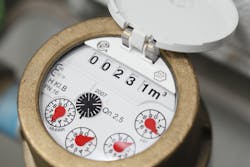In the early days of the petroleum industry here in the United States, the object of the refining process was to obtain kerosene, a valuable substance people could use to fuel their lamps. A by-product of the process was a lighter, more volatile substance called gasoline—which was considered waste and typically dumped in the nearest river.
Luckily, science and technology caught up with industry and found more than a few practical uses for gasoline. But here, now, in the 21st century, we are still throwing away valuable energy, as well as wasting precious water. The pace of technological change has accelerated so much in just the past few decades that incredible new ways to save energy and water are now possible, and in the savings to be had there is money to be made.
Case in point, check out this month’s feature. In it you’ll read about a new high-tech leak detection and metering system that is being implemented by the city of Toledo, OH. That new system is going to take 32 months to build out and is expected to cost $85.7 million dollars—but the rate payers of Toledo will not be paying one red cent for it.
Why? Because the current system wastes something between $5 and $6 million dollars’ worth of water every year. All it required was the right kind of public-private partnership combined with the right financing program and the project pays for itself.
For something that hits closer to home, look at the leaps and bounds boiler technology has made in such a short time. The typical commercial boiler currently in-use has an efficiency somewhere between 84% and 86%. There are now lines of condensing commercial boilers available that can offer efficiencies of 97% or even higher. If you are a building manager and your boiler is already pushing its 15–20-year lifespan, if you’re going to have to replace it soon anyway, why wouldn’t you opt for that kind of return on investment?
(Not too very long ago I spoke with Crossfire Mechanical out in Burmuda Dunes, CA, and all they do is commercial tankless boiler retrofit and replacement. You can read about it by going to “Hot Water in a Hurry.”)
Waste heat recovery is another way the new systems can take energy we used to be throwing away and put it to use. Co-generation systems take the heat coming from producing electricity—the engine, the exhaust, the generator—and use it to pre-heat the building’s water. I’ve even heard of systems that are drawing the waste heat off of server rooms and using it to reduce the water heating load.
Boilers used to be oversized. There was a time when oil or coal was relatively cheap, and system designers tended to err on the side of greater heating capacity. Those old systems aren’t so common these days, but there is still one area where designers are regularly oversizing, and in doing so creating inefficient systems: piping.
For almost 80 years, designers had been using Hunter’s Curve to size pipes. It wasn’t until 2018 that IAPMO, ASPE and the University of Cincinnati collaborated to create the Water Demand Calculator (which was eventually incorporated in the UPC as “Appendix M”). The results? Less water trapped inside plumbing systems produced greater water efficiency; faster hot water delivery led to improved energy efficiency; and—added bonus—significant cost savings on piping materials. You can read all about the efforts to expand the Water Demand Calculator to cover commercial buildings in our latest Forum. Think of the savings to be had at commercial scale!
Technology certainly isn’t the cure for all the troubles in the world, but if it can move the efficiency needle just a little bit, there are huge benefits to be reaped over time.
About the Author
Steve Spaulding
Editor-in-Chief - CONTRACTOR
Steve Spaulding is Editor-in-Chief for CONTRACTOR Magazine. He has been with the magazine since 1996, and has contributed to Radiant Living, NATE Magazine, and other Endeavor Media properties.
